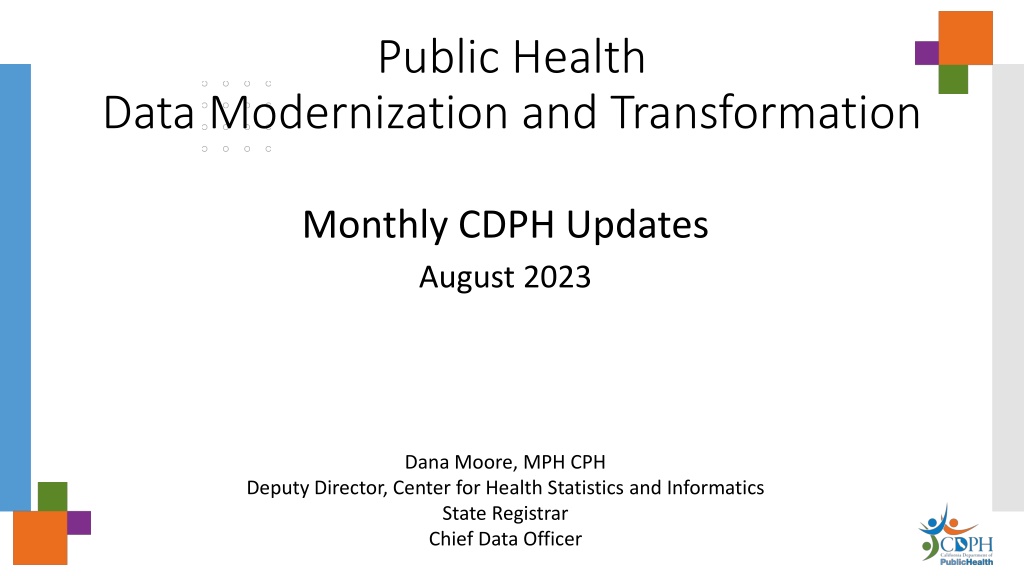Public Health Data Modernization and Transformation Updates
Explore the latest updates and key areas in Public Health Data Modernization and Transformation, including California Health and Human Services Agency initiatives, data governance standards, and system enhancements. Learn about the distinction between data modernization and transformation, and how these processes impact organizational operations and efficiencies.
Download Presentation

Please find below an Image/Link to download the presentation.
The content on the website is provided AS IS for your information and personal use only. It may not be sold, licensed, or shared on other websites without obtaining consent from the author. Download presentation by click this link. If you encounter any issues during the download, it is possible that the publisher has removed the file from their server.
E N D
Presentation Transcript
Public Health Data Modernization and Transformation Monthly CDPH Updates August 2023 Dana Moore, MPH CPH Deputy Director, Center for Health Statistics and Informatics State Registrar Chief Data Officer
Purpose Updates Next Steps Q&A Agenda
Provide highlights and critical updates and solicit input in key areas: Provide highlights and critical updates and solicit input in key areas: California Health and Human Services Agency Departments Data Exchange Framework (CDII) Person Identity Matching Capability Project (CDII) CalHHSA Data Governance and Standards (CDII) Data Disaggregation Guidelines (CDII) Common Data Application/ Business Use Case Proposal California Department of Public Health Data Systems Transformation Data Modernization Initiative-DMI-CDC Infrastructure Information Technology-Future of Public Health Self-Assessment Tool and TA Guide CDPH Data Governance and Standards Committees Workgroups and Taskforces (e.g., SOGI, Surveillance, Epi Forum) Syndromic Surveillance/Center for Preparedness and Response 24-7 Data Hub Vital Records and Vital Statistics Modernization and Transformation
Data Systems Capabilities Self-Assessment Tool Updates Data Systems Capabilities Technical Assistance Guide
Data Modernization vs. Transformation Modernization All about applying the latest technologies, methodologies, and models including cloud, agile, automation, and containerization to an organization s legacy IT infrastructure, architecture, and products to maximize resiliency, efficiency, agility, and speed. Enhances the performance of existing products and systems without changing the business operating model, while digital transformation fundamentally improves the business operating model itself. Refers to the updating or upgrading of existing technology systems. Transformation Transformation relies on digital technologies to dramatically improve how our organization meets the changing needs of public health and our stakeholders or improves process efficiencies. Transformation involves a radical change in the way an organization operates, fundamentally improving the operating model itself. While modernization shares some of the key benefits of digital transformation, the key difference lies in the span of influence within the department.
Data Systems Capabilities: Maturity Model Foundational Concepts Data-sharing capacity is likely to be highly variable across and within LHJs Public health, health care, and social and community service organizations operate in increasingly data-rich environments Information is generally collected in silos, by individual organizations, funders and payers Challenges with constraints on sharing to ensure compliance with HIPAA and other health information and privacy policies Data is more easily share first within an organization/agency/sector, then across sectors/organizations Data sharing moves at the speed of trust
Data Systems Capabilities Self Assessment Tool Voluntary resource to aid in planning and priority setting for data and IT modernization/transformation at local and state levels Information and information technology as a shared and strategic asset Public Health Informatics Institute, RWJF, CDC, CHOIR (UCB) LHJs and CDPH programs at different stages of readiness and capacity for data modernization and transformation Not uncommon for organizations, even successful ones, to be at relatively low levels of this model This reflects the organizational challenges that are inevitable with formally establishing new ways of working across an organization and then rigorously evaluating that work.
Data Systems Capabilities Self Assessment Tool Ranking General description 0 - Absent No capability is evident; starting from scratch. No organized, systematic efforts to build informatics capacity, only ad hoc efforts and isolated, individual heroics. 1 - Initial Some organized efforts begun or completed, but not systematically documented or institutionalized. 2 - Managed Systematic, ongoing efforts underway, but no overall method to measure progress or to ensure coordination. 3 Defined Systematic, ongoing efforts underway to measure progress and ensure coordination. 4 - Measured Systematic, ongoing efforts underway with quality improvement activities to align results with guiding vision, strategies and performance metrics. 5 - Optimized
Data Systems Capabilities Infrastructure Funding IT and Enterprise Architecture Interoperability Systems and Data Inventory/ Metadata Effectively Used and Well-Designed Systems Workforce Communications Relationships/Buy-in /Stakeholders Vision, Strategy, Purpose, Aim Governance Policies, Procedures, and Practice Project Management Data Exchange Data Management and Data Quality Automation Privacy and Security Informatics and Analytics
Release draft tool and guide for input Host Local input and listening sessions Host CDPH program input and listening sessions CDPH continue to update and refine the tool and TA guide Release of tool and TA guide Voluntary, and highly encouraged Collect data and identify gaps and trends Inform the CDPH data modernization and transformation strategy and LHJ outreach Share findings Establish a community of practice Next Steps
Feedback and Questions
THANK YOU! Contact Information Data Dana Moore, Deputy Director, State Registrar, Chief Data Officer Center for Health Statistics & Informatics Dana.Moore@cdph.ca.gov Technology John Roussel, Deputy Director, Chief Information Officer Information Technology Services Division John.Roussel@cdph.ca.gov






























